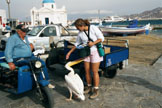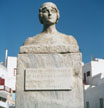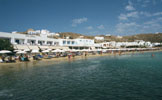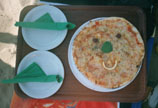|

Mykonos
Originally visited only
as a stop on the way to ancient Delos,
Mykonos
has easily become the most popular island of the Cyclades.
In the classic port town of Chora, or Mykonos Town,, the whitewashed
houses huddle together against the winds in the mazelike
white marble streets. The town's whitewashed streets, its
cubical houses and churches with their dashes of sky-blue
doors and domes are the stereotype of classic Cycladic
architecture. The dry and rugged island is one of the
smallest of the Cycladic group at only 10 miles (16 km) long,
7 miles (11 km) wide and about 33 sq mi (85 sq km) in area.
According to legend it is the piece of rock thrown by Hercules
to destroy the Giants.
Click on the thumbnails below in order to see pictures of Mykonos. Use your browser's back button
to return to this page.

|
|
|
|
|
 The
Kouros
Hotel, our fabulous abode during our stay in Mykonos. The
Kouros
Hotel, our fabulous abode during our stay in Mykonos. |
|
 The
view from our balcony at the Kouros includes one of the many churches on
the island. Mykoniots claim that exactly 365 churches and chapels dot
their landscape, one for each day of the year. The
view from our balcony at the Kouros includes one of the many churches on
the island. Mykoniots claim that exactly 365 churches and chapels dot
their landscape, one for each day of the year. |
|
 View
of Mykonos Town from our balcony at the Kouros. The very large ship is one
the inter-island ferries. View
of Mykonos Town from our balcony at the Kouros. The very large ship is one
the inter-island ferries. |
|
|
|
|
|
 Mykonos Town. Mykonos Town. |
|
 Mykonos Town
as seen from the Delos ferry. Mykonos Town
as seen from the Delos ferry. |
|
 Beautiful
Chora with its dazzling white cuboid houses, quaint churches and
windmills. Its sparse landscape has rapidly developed into one of the most
famous vacation spots in Greece and symbol of the picturesque Aegean. Beautiful
Chora with its dazzling white cuboid houses, quaint churches and
windmills. Its sparse landscape has rapidly developed into one of the most
famous vacation spots in Greece and symbol of the picturesque Aegean. |
|
|
|
|
|
 Mykonos Town. Mykonos Town. |
|
 We
were lucky enough to see the town mascot, Petros the Pelican and his mate,
Irini, along the waterfront where the boats dock. In the 1950s, a group of
migrating pelicans passed over Mykonos leaving behind one exhausted bird.
Vassilis the fisherman nursed it back to health. This is his successor, enjoying
the spotlight and carrying on the tradition. We
were lucky enough to see the town mascot, Petros the Pelican and his mate,
Irini, along the waterfront where the boats dock. In the 1950s, a group of
migrating pelicans passed over Mykonos leaving behind one exhausted bird.
Vassilis the fisherman nursed it back to health. This is his successor, enjoying
the spotlight and carrying on the tradition. |
|
 The
bust of Mando Mavroyennis, the island heroine, stands on a pedestal in the
main square in Mykonos Town. In the War of Independence, the Mykoniots,
known for their naval and seafaring skills, volunteered an armada of 24
ships, and in 1822, when the Ottomans later landed a force on the island,
Mavroyennis and her soldiers forced them back to their ships. The
bust of Mando Mavroyennis, the island heroine, stands on a pedestal in the
main square in Mykonos Town. In the War of Independence, the Mykoniots,
known for their naval and seafaring skills, volunteered an armada of 24
ships, and in 1822, when the Ottomans later landed a force on the island,
Mavroyennis and her soldiers forced them back to their ships. |
|
|
|
|
|
 One
of the principal
characteristics of the landscape of Chora are the windmills with their
solid cylindrical form and light sails. Their familiar silhouettes enhance
to the utmost the picturesque aspect of Mykonos. One
of the principal
characteristics of the landscape of Chora are the windmills with their
solid cylindrical form and light sails. Their familiar silhouettes enhance
to the utmost the picturesque aspect of Mykonos. |
|
 Little
Venice and the lower windmills (Kato Myloi). The windmills were
used to grind the island's grain. Little
Venice and the lower windmills (Kato Myloi). The windmills were
used to grind the island's grain. |
|
 The
lower windmills as seen from Little Venice. The
lower windmills as seen from Little Venice. |
|
|
|
|
|
 Many
of the early ship captains built distinguished homes with wooden balconies
over the water at the southwest end of the port. A few of the old houses
have been turned into stylish bars. This
stretch of waterfront homes, cafes, and bars is now called Little
Venice,
although its real name is AlefkŠndhra. Many
of the early ship captains built distinguished homes with wooden balconies
over the water at the southwest end of the port. A few of the old houses
have been turned into stylish bars. This
stretch of waterfront homes, cafes, and bars is now called Little
Venice,
although its real name is AlefkŠndhra. |
|
 Octopus...
it's what's for dinner... although not my dinner. I prefer swordfish!
J
These
were hanging to dry at a small restaurant near the lower windmills and
Little Venice. Octopus...
it's what's for dinner... although not my dinner. I prefer swordfish!
J
These
were hanging to dry at a small restaurant near the lower windmills and
Little Venice. |
|
 The
sunset as seen from Mykonos Town. The
sunset as seen from Mykonos Town. |
|
|
|
|
|
 The
best beaches on Mykonos are located on the south side of the island
where they are sheltered from the prevailing wind. Platis
Gialos, pictured here, is just one of the many beaches on the south side. The
best beaches on Mykonos are located on the south side of the island
where they are sheltered from the prevailing wind. Platis
Gialos, pictured here, is just one of the many beaches on the south side. |
|
 Platis
Gialos, perhaps the most frequented beach of Mykonos. Platis
Gialos, perhaps the most frequented beach of Mykonos. |
|
 Platis
Gialos. Platis
Gialos. |
|
|
|
|
|
 Our
waiter at Platis
Gialos had a sense of humor. :-) Our
waiter at Platis
Gialos had a sense of humor. :-) |
|
 Jeff
at Platis
Gialos. Jeff
at Platis
Gialos. |
|
 Leaving Mykonos. Leaving Mykonos. |
|
|
|
|
|
© All pictures are Copyright 2000 Grisel Gonzalez and Jeff
Prosise
|